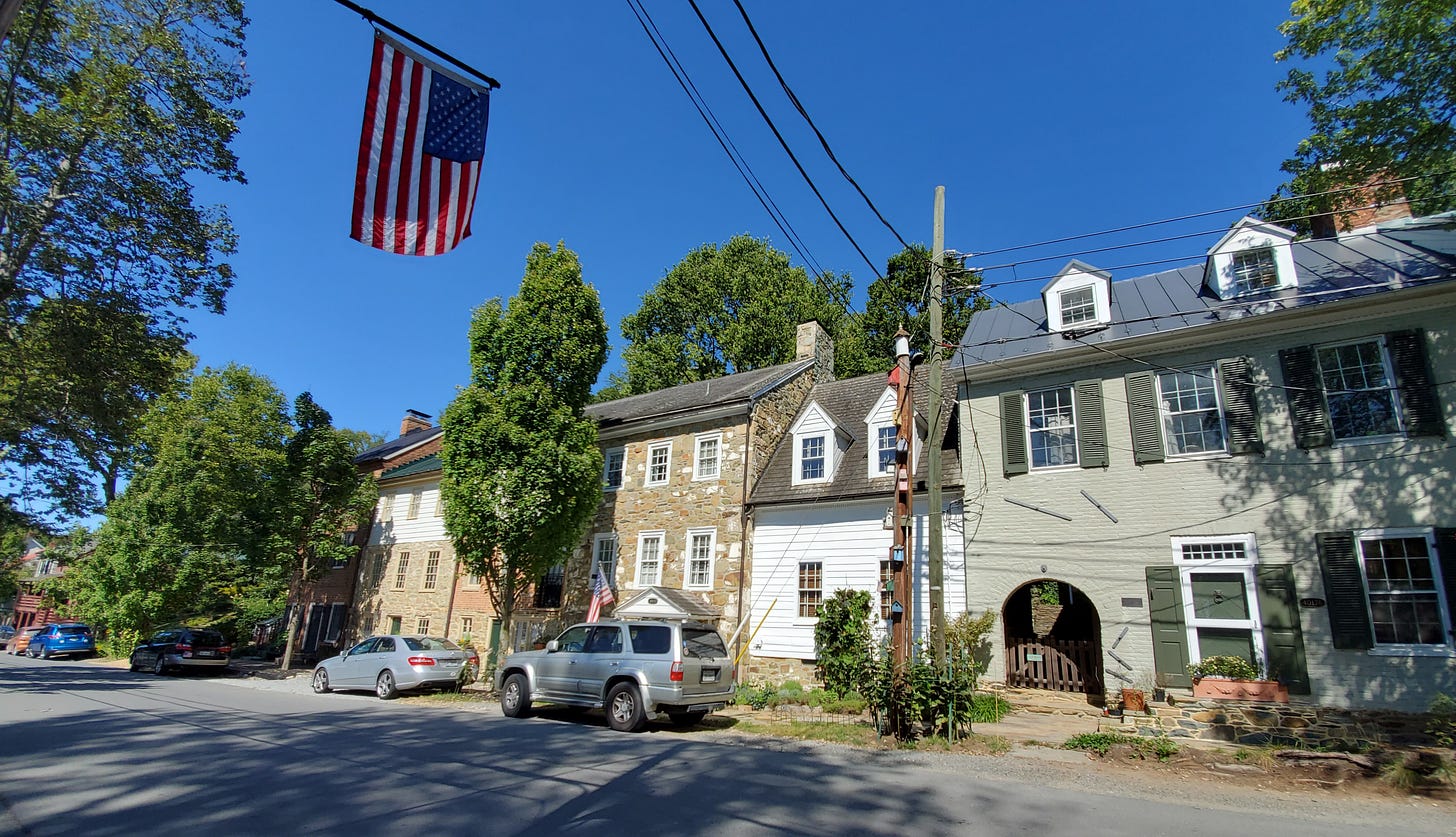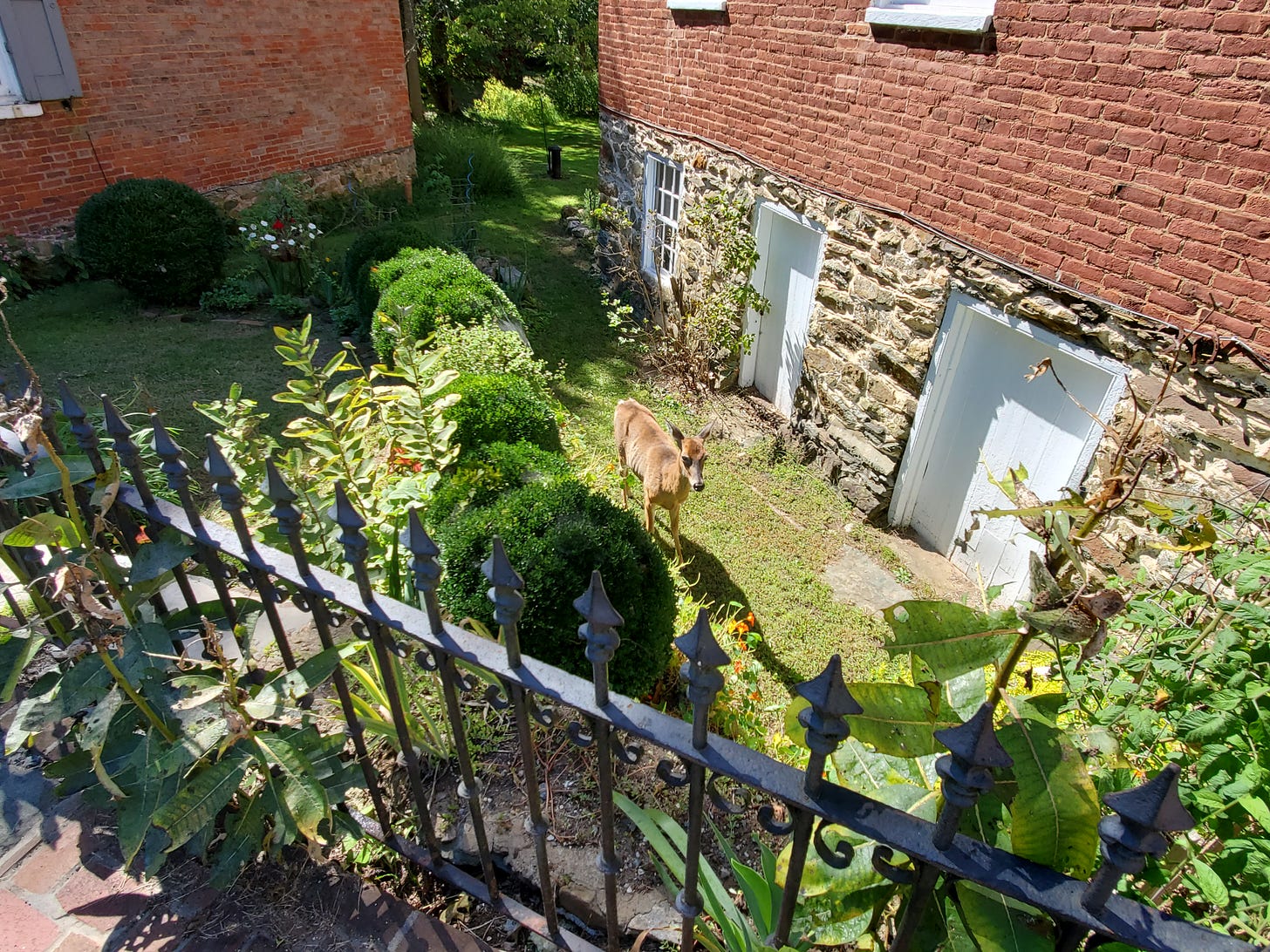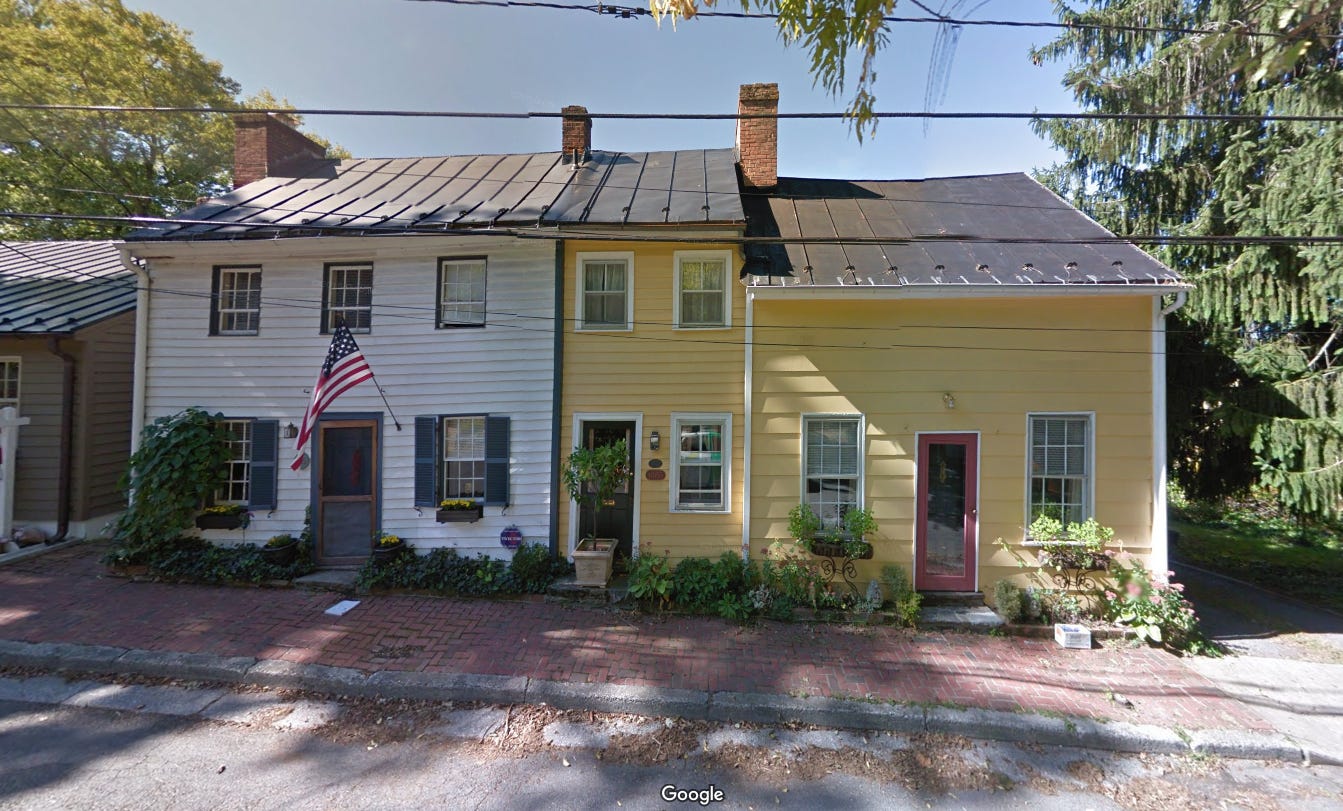What Does Waterford Mean?
I try to learn something from a tiny historic village in Northern Virginia
When the third middle-aged man told me I needed to check out Waterford, I figured it was at least worth a visit.
Waterford is a rural, former farming and mill village in northwestern Loudoun County, Virginia, several miles past Leesburg. It’s nearly at the northwestern corner of the D.C. metro area, and past the exurban fringe. The countryside out here is lovely, full of farms, fields, and wineries, and the town’s buildings are historic. In fact, the entire village and some of the surrounding land is a National Historic Landmark District, with many of the buildings surviving more or less fully intact from their 18th or 19th century appearances. Waterford was largely settled and built by Quakers, who were known for their architecture. Few settlements in America are so substantially preserved, and few were built quite so well to begin with. (All photos mine, except the last one.)
However, it’s easy to think you’ve gotten lost if you’re looking for Waterford; it is absolutely tiny. A lot of places that are called “towns” are really small cities; Waterford, however, is so small that even “small town” over-describes it. There’s an embryonic street grid, a school, a church, a single store, and no restaurants or inns. The village is about one-third of a square mile. If you look up Waterford’s population, you’ll get over 2,000, but that includes much of the nearby countryside. I can’t find a population number just for the village itself, but it can’t be more than 300 or 400.
Area homes, of much newer construction, approach or exceed $1 million, nearly 50 miles out from Washington, D.C. None of the 97 historic homes in the actual village—64 percent of which were built before 1861—are currently on the market. And they’re not going to be cheap. Waterford’s official website states:
Residents of Waterford see themselves as caretakers of the historic homes where they live. They maintain their houses so that they reflect their history and only make changes that will not adversely change the character of the village. In one hundred years from now, the village will hopefully look as it does today.
(That final sentence sounds like a parody of NIMBYism, but I think it’s okay if some places stay the same.) Waterford reminds me a bit of Riegelsville, the small, lovely Pennsylvania canal town I wrote about last week. However, Waterford is even smaller and more exclusive. And, unless you’re a Quaker or Civil War history buff, it’s probably less interesting. Aside from the late-fall yearly fair, the town itself is insufficient for a day trip. (If you’re looking for a livelier small town in Loudoun County, Middleburg is a wonderful option. I guess I have to write about that too!)
My first thought upon visiting this historical curiosity was, what does this mean? What, if anything, can it say about urbanism or land use or place? I have a hard time drawing any broader lessons from Waterford.
I don’t think exclusive is the same thing as exclusionary, but it’s tough, as someone who generally supports more housing and more density, to point to a place like this as a template. But on the other hand, as I said of Riegelsville, places like this are examples of “what’s possible in design, architecture, livability, and beauty at a given size and density.”
The fact is that Waterford or Riegelsville are both denser and more beautiful than any McMansion subdivision being built today. Their relatively high prices certainly speak to the affluence of their populations, but they’re also market signals. Perhaps they’re even evidence that the late Roger Scruton was correct that architectural beauty could be employed to fight NIMBYism. I’m not sure. But I’m not going to resent exclusive small towns when they compare very favorably against so much of the McMansion development going on.
On a related note, in fact, one of the most interesting things about Waterford is that it has not actually been a continually affluent place. It was listed as a Virginia Historic Landmark in 1969, and a National Historic Landmark in 1970. But the town’s Wikipedia article explains:
With the town falling into disrepair in the early part of the 20th century, the Waterford Foundation was formed to help save and preserve Waterford and its history. In 1974, the Waterford Foundation helped create an innovative land preservation program in which the historic properties of Waterford are protected through open space and façade easements. More than 60 easements have been granted.
And the official Waterford website states: “Many Waterford houses were not maintained before 1940. This disrepair allowed these Waterford homes to remain in their original condition which you can see today after their restoration.”
A little aside here: It’s fascinating to me that abandonment and disrepair actually preserved these buildings. The same thing is true of a lot of early roadside development along bypassed U.S. Highways. This is one reason a lot of urbanists and housing advocates look askance at historic preservation; they associate it with artificially holding back growth, arresting the normal process by which lively places rebuild and reinvent themselves over time. I don’t really think preservation and growth are inherently at odds myself; there are many lively cities in Europe whose skylines have existed in recognizable form for longer than the United States has existed.
But back to Waterford’s 20th century rediscovery. I found this very interesting, because the same basic dynamic unfolded in Clifton, another small Northern Virginia town that I recently visited and will be writing about later. In fact, it’s true of a lot of places, including the historic downtown of Annapolis, Maryland, and Old Town Alexandria, both of which were severely neglected and under threat of redevelopment. There was a period when traditionally built places, whether remote like Waterford or central like Alexandria, simply fell out of favor.
I think it’s unquestionably a good thing that they’re back in favor, and I’ll wrap up here with a more general point. They’re evidence, just as the high prices of New Urbanist developments are evidence, that there’s a market for the combination of density, urbanity, and beauty. There are many more neglected urban places to be enlivened again. And there’s a lot of greenfield land that’s still being turned into subdivisions. Those who consider New Urbanism or gentle density insufficient are comparing it to the densest or the most housing-crunched cities, not to all the development which fails to learn anything at all from the failure of the suburban experiment.
This post, like most of what’s here, is free for all web viewers and subscribers. I’ve committed to one post per day here, and roughly once a week, I’ll also be posting pieces like this documenting places around the region. Please do consider a paid subscription to help make this viable and continue to grow. Thank you for reading!










Great article, Addison. Waterford is an exquisitely lovely little town "off the beaten path" of the burgeoning exurban DC sprawl. The preservation of beauty is a worthwhile trade-off for McMansion developments and a broader tax base (as seen in the highest-income strata VA town of Upperville). Waterford also has the advantage of not being a through-village like nearby Hillsboro, also a lovely little place.
One example of a small town caught between a historical central main street and upper-income strata growth in the outlying environs is Libertytown, Maryland, which might be worth a trip for you to drive out there and examine. The old village has a busy artery (MD RT 26) that connects Frederick to Baltimore running through the main street. https://www.fredericknewspost.com/news/community_page_news/bulletin/libertytown-at-a-crossroads/article_2a4b81fd-c1a9-53cf-b6ca-7e947d43a03b.html
Thank you for such a thoughtful piece on my hometown. I have never met anyone from anywhere else with such deep connections as those of us who grew up in Waterford have; possibly because it was so small, and we all knew each other and could not really choose friends because there were not that many of us! And in a society where people report fewer connections to others, people who have lived in Waterford remain connected, through having lived in this tiny village, for a long time. I’m sure neighbors are as welcoming now as they were to my parents in 1969 when we moved there, too. It’s such an active and vital community, and a wonderful place to have kids or to be a kid.